Tax Inversions and Carbon Taxes
Because the US has the highest corporate tax rate in the world, firms can save billions of dollars by attaining a new corporate address in a low-tax country without physically relocating any of their existing business. To do so, American firms simply need to acquire a foreign firm and reincorporate the newly formed company abroad. Since 2012, 12 US firms have successfully moved offshore and many more are attempting to follow, including AbbVie, in a deal to buy British-based Shire for $55 billion and Medtronic’s deal to purchase Irish device maker Covidian for $43 billion. This strategy is known as a “tax inversion” and this post explores how a tax on carbon can help prevent them.
Not surprisingly, inversions cost the US treasury tax revenue, and the recent wave of new inversions has caught the attention of the White House and members of Congress. In July, Treasury Secretary Jack Lew called for “economic patriotism” in an effort to persuade Congress to act on the matter and President Obama declared, “I don’t care if it’s legal. It’s wrong.” Just last week, Democratic Senators called for unilateral executive action and both Secretary Lew and President Obama announced an examination of whether or not the Treasury has the authority to “discourage some of the folks who may be trying to take advantage” of inversions.
Yet inversions are simply a symptom of a much wider problem: our broken corporate tax code. High marginal rates, large loopholes, and a system that tries to tax profits earned abroad puts US companies at a disadvantage relative to their foreign competitors, promoting inversion. Instead of focusing on inversions, our policymakers should concentrate their efforts on meaningful corporate tax reform.
So how would a tax on carbon prevent tax inversions? Carbon taxes have the potential to raise billions of dollars each year that could finance the type of tax reform that would make US corporations more competitive and reduce their incentive for inversion. Further, a carbon tax combined with corporate tax reform is an extremely efficient method of reducing harmful greenhouse gases. In a recent RFF discussion paper, my coauthor Lawrence H. Goulder of Stanford University and I show that the most cost-effective carbon tax is the one that uses its revenues to finance corporate tax rate cuts.
While the political landscape has not been kind to recent so-called “grand bargains,” a bill that establishes a carbon tax while reducing corporate tax rates could satisfy members on both sides of the aisle. My grand bargain would give Democrats an efficient and legally binding climate policy (to replace the less-efficient and legally uncertain EPA power plant rules) and it would give Republicans meaningful corporate tax reform. Sounds like a win-win to me.
Exporting the Cost of Dams
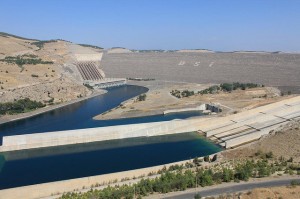
Ataturk Dam, Turkey (credit: Carsten ten Brink / flickr)
Last year, former Egyptian President Mohamed Morsi proclaimed: “We will defend each drop of Nile water with our blood if necessary.” He was referring to the Grand Ethiopian Renaissance Dam that Ethiopia is constructing, which may affect the flow of the Nile River into Egypt. A year later, talks between the two nations still have not progressed.
For years, economists have been concerned that the local benefits of dams have been overstated and the local costs have been understated. Even if countries make efficient decisions about dam construction on domestic rivers, countries sharing a river may overdevelop the river if they are able to pass on some of the costs imposed by dams to other countries. As evidenced in the Egypt-Ethiopia dilemma, these issues may create the potential for conflict across borders when countries share a river. Read More
Measuring the Early Effects of a Carbon Tax: Comparing Three Policies across Income Groups
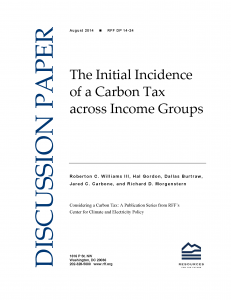 Economists argue that the most efficient way to reduce greenhouse gas emissions is to raise the price of energy by introducing a price on carbon emissions, either through a tax or a cap-and-trade regime. A tax (or a cap-and-trade system that auctions off permits) has a secondary effect beyond providing incentives for reducing emissions: it raises a lot of new government revenue. Just what is done with this revenue weighs heavily on the distributional effects of a carbon price; in fact, it has greater relevance to the distributional outcome than the actual price on carbon emissions. In a new RFF discussion paper, with RFF’s Rob Williams and Richard Morgenstern, and Jared Carbone of the University of Calgary, we analyzed three different options for allocating the revenue from a $30 per-ton tax on carbon (which translates to $192 billion in the first year), and the effects on the distribution of the cost burden across income groups in the United States. These effects change over time. We focus here on the initial effects at the outset of the policy because these near-term consequences are the most salient in the contemporary political dialogue.
Economists argue that the most efficient way to reduce greenhouse gas emissions is to raise the price of energy by introducing a price on carbon emissions, either through a tax or a cap-and-trade regime. A tax (or a cap-and-trade system that auctions off permits) has a secondary effect beyond providing incentives for reducing emissions: it raises a lot of new government revenue. Just what is done with this revenue weighs heavily on the distributional effects of a carbon price; in fact, it has greater relevance to the distributional outcome than the actual price on carbon emissions. In a new RFF discussion paper, with RFF’s Rob Williams and Richard Morgenstern, and Jared Carbone of the University of Calgary, we analyzed three different options for allocating the revenue from a $30 per-ton tax on carbon (which translates to $192 billion in the first year), and the effects on the distribution of the cost burden across income groups in the United States. These effects change over time. We focus here on the initial effects at the outset of the policy because these near-term consequences are the most salient in the contemporary political dialogue.
Most carbon tax proposals plan to return the money collected by the government to the people. For instance, California’s cap-and-trade scheme returns much of the revenue to utility customers with a biannual “climate credit.” The three policies we examine would recycle all carbon tax revenue—that is, the level of governments spending would not change. In one policy, an equal share of the revenue is returned to each resident in the form of a lump-sum rebate. In another, the revenue is used to pay for a cut in the marginal labor tax. And in a third, it pays for a cut in marginal capital taxes. The tax cuts are implemented as an equal percentage reduction in the tax rate at all income levels, although different approaches would have different effects. It has been well established that total economic efficiency is expected to be greatest when the revenue from a carbon tax is used to reduce the capital tax and next best when it is used to reduce the labor tax because, in each case, the policy substitutes for a preexisting distortionary policy. A lump-sum rebate does not share this characteristic. However, economic efficiency comes with particular distributional outcomes that should also be evaluated.
Resources Magazine: Reflections on the Oil Shock of 40 Years Ago
The 1973-1974 energy crisis produced many lessons, but Joel Darmstadter cautions that the benefits of moving toward US energy independence should not be overdrawn.
In recalling those oil producers “whose embargo once brought the industrial world to its knees” (Baltimore Sun), commemorative coverage of the worldwide price shock of 1973–1974 may sometimes veer toward the dramatic. Still, one would have to be a committed contrarian to downplay the seriousness of the shock. The virtually unprecedented and precipitous more-than-threefold increase in the real price of a barrel of oil not only produced significant near-term economic damage in the United States and elsewhere but also sharpened intense policy concerns about the implications for future vulnerability of energy-dependent societies.
Background on the Crisis
What key elements drove that upheaval of 40 years ago? No episode of turbulence in the Middle East exists in isolation from what has gone before and is likely to recur. That said, the oil shock’s precipitating genesis was the outbreak on October 6, 1973, of the Yom Kippur War. This conflict, the fourth Arab–Israeli war in 25 years, began with a coordinated attack by Syria and Egypt in an effort to reclaim lands lost to Israel during the 1967 Six-Day War.
The October outbreak of hostilities was followed by two events—the first was political and, as it turned out, largely symbolic; the second was painfully economic. First, in October 1973, the Arab–Israeli conflict prompted a group of Arab oil producers to institute a selective embargo on oil exports. The second development was a collective decision by member countries of the Organization of the Petroleum Exporting Countries (OPEC) to raise the price of oil.
The embargo, by far the easier issue to consider, was conducted by a somewhat shifting group of Arab oil exporters that embraced a fairly ambiguous set of goals during its relatively brief six-month existence. (The embargo was formally terminated in March 1974.) In essence, it targeted the United States and the Netherlands with oil delivery shortfalls as a protest against the two nations’ presumed support of Israel. Yet, to demonstrate the achievement of this objective—or that of any embargo—one would need to find statistical evidence of manipulated and extended export restrictions. No such evidence exists, notwithstanding an embargo announcement, pledging supportive output reductions.
Several major non-Arab oil producers (and OPEC members)—among them Venezuela and Iran—failed to join the embargo. In addition, all indications suggest that an effective rerouting of world oil flows spared the intended targets any major disruption in supply. These logistical responses, though no doubt entailing some added transportation costs, are separable from the genuine damage inflicted by the steep rise in oil prices. In short, it is hard not to view the embargo as a largely symbolic and limited expression of political sympathy by Arab oil producers.
If, judged by its futility, the embargo was mostly a token gesture, the dramatic rise in the price of oil was anything but. To probe how the world demand for and supply of oil came to intersect and settle at such a dramatically higher price, one needs to explore the degree to which shifting consumption, production, or both represented the principal driver of change. In fact, a good case can be made that both factors did play an important role.
Read the rest of this article.
RFF on the Issues: Clean Power Plan comments; Natural gas price drop
Clean Power Plan Comments
The US Environmental Protection Agency (EPA) has wrapped up a series of four hearings inviting oral comments on the Obama administration’s Clean Power Plan proposal, which is currently open for public comment until October 16. The agency has highlighted multi-state plans, target methodology, and their proposed “best system” to achieve emissions reductions as areas that would particularly benefit from public input.
In a recent blog post, RFF’s Anthony Paul and Sophie Pan break down the four “building block” components that together form EPA’s “best system” for meeting state carbon dioxideemissions targets. They note that calculating the emissions reductions that can be achieved under the blocks individually is important “in the case where some building blocks don’t survive legal challenge.” The authors conclude that block number two—involving shifts to natural gas—might offer the biggest potential emissions reductions.
Natural Gas Price Drop
Cool weather and increasing inventories have caused the price of natural gas futures to drop below $4 per million Btu, to its lowest seasonal price in 13 years, with both trends projected to continue over the next few months. These unusually low prices are also “prompting power plants to switch from coal,” even as output from natural gas generators continues to fall.
In a new discussion paper, RFF’s Joshua Linn, Lucija Muehlenbachs, and Yushuang Wang show how with lower natural gas prices, electricity prices and emissions fall—but not in lockstep. Muehlenbachs explains in a follow-up post: “When there is more switching, we see a smaller drop in the electricity price (because prices are set at the now-higher cost of coal-fired generation, not the falling cost of natural gas). But at the same time, with more switching, we see a larger drop in emissions. So, ultimately, the more that electricity consumers benefit from a price drop, the less we see environmental benefits.”
This Week in the RFF Library Blog
Each week, we review the papers, studies, reports, and briefings posted at the “indispensable” RFF Library Blog, curated by RFF Librarian Chris Clotworthy.
Groundwater Depletion During Drought Threatens Future Water Security of the Colorado River Basin
[Green Car Congress] A new satellite study finds more than 75% of the water loss in the drought-stricken Colorado River Basin since late 2004 came from underground resources. The extent of groundwater loss may pose a greater threat to the water supply of the western United States than previously thought. This study is the first to quantify the amount that groundwater contributes to the water needs of western states. According to the US Bureau of Reclamation, the federal water management agency, the basin has been suffering from prolonged, severe drought since 2000 and has experienced the driest 14-year period in the last hundred years. The study has been accepted for publication in Geophysical Research Letters, a journal of the American Geophysical Union… – via Geophysical Research Letters
The Value of US Power Diversity: Diversity of United States Power Supply Could be Significantly Reduced in Coming Decades
Diversity in the US power supply—the most cost-effective means of managing the inherent risks in fuel costs and technology performance in generating power—could be dramatically reduced in coming decades. Fuel and technology decisions on new supply that will determine as much as one-third of US power supply will be required in the coming decades… – via IHS (free download with registration)
This Week in the RFF Library Blog
Each week, we review the papers, studies, reports, and briefings posted at the “indispensable” RFF Library Blog, curated by RFF Librarian Chris Clotworthy.
EPA’s Clean Power Plan: States’ Tools for Reducing Costs & Increasing Benefits to Consumers
[Press Release] States are well positioned to implement the U.S. Environmental Protection Agency’s (EPA) recently proposed Clean Power Plan, according to a new report from Analysis Group. The report, funded by the Energy Foundation and the Merck Family Fund, was released at the National Association of Regulatory Utility Commissioners’ conference in Dallas. Analysis Group says the study is based on a careful analysis of states that already have experience regulating carbon pollution. It finds that those states’ economies have seen net increases in economic output and jobs… – via The Analysis Group for the Energy Foundation and the Merck Family Fund / by Paul Hibbard, et al.
Public Views on a Carbon Tax Depend on the Proposed Use of Revenue: New Report
[EcoWatch] While some U.S. are lukewarm on the idea of taxing fossil fuel companies for emitting carbon, more are willing to support a tax if the funds support cleaner energy. According to the University of Michigan and Muhlenberg College’s Spring 2014 National Surveys on Energy and Environment (NSEE), most Americans—56 percent—support a revenue-neutral carbon tax, in which all tax revenue would be returned to the public as a rebate check. However, that amount rises to 60 percent if revenues would be used to fund research and development for renewable energy programs… – via National Surveys on Energy and Environment
The Impact of Natural Gas Prices on Electricity Consumers and the Environment
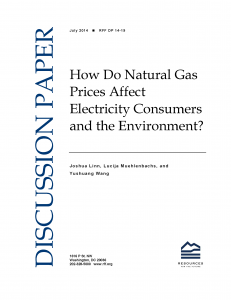 Coinciding with the recent increase in US natural gas production, the country has seen a 60 percent decrease in the price of natural gas. Lower natural gas prices have affected electricity prices and emissions rates differently across various regions. For example, during this time period, the Texas Reliability Entity experienced one of the largest decreases in the price of electricity but also one of the smallest decreases in the rate of emissions; whereas the ReliabilityFirst Corporation experienced one of the smallest decreases in the electricity price but one of the largest decreases in the emissions rate. Together with my coauthors, in a new RFF discussion paper, we theoretically and empirically explore the interrelated effects of lower natural gas prices on power plant operators, electricity consumers, and the environment, finding that lower electricity prices typically translate to less environmental benefits. Read More
Coinciding with the recent increase in US natural gas production, the country has seen a 60 percent decrease in the price of natural gas. Lower natural gas prices have affected electricity prices and emissions rates differently across various regions. For example, during this time period, the Texas Reliability Entity experienced one of the largest decreases in the price of electricity but also one of the smallest decreases in the rate of emissions; whereas the ReliabilityFirst Corporation experienced one of the smallest decreases in the electricity price but one of the largest decreases in the emissions rate. Together with my coauthors, in a new RFF discussion paper, we theoretically and empirically explore the interrelated effects of lower natural gas prices on power plant operators, electricity consumers, and the environment, finding that lower electricity prices typically translate to less environmental benefits. Read More
The Federal Multiagency Collaboration on Unconventional Oil and Gas Research Strategy: What Have We Learned?
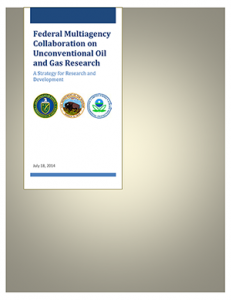 The Department of Energy, the Department of the Interior, and the Environmental Protection Agency recently released the long-awaited research strategy on unconventional oil and gas research. Its mandate was to produce timely, policy-relevant research questions that support sound policy decisions and prudent oil and gas development. It also was to “analyze and synthesize the state of knowledge.” While the strategy it provides poses broad natural and physical science questions, it omits many important areas and ignores the social sciences and research on current or future regulations and use of other tools. Time and again, we have seen major federal efforts follow this self-defeating, all hard science route—think the $500 million National Acid Precipitation Assessment Program. The fact is that there are numerous, policy-relevant social science research questions—many of them identified in our RFF report “The Natural Gas Revolution: Critical Questions for a Sustainable Energy Future”—that are vital to meeting this interagency mandate. Indeed, without answering these questions, (concerning, for example, the appropriate design of regulations and mix of liability and regulation, the appropriate allocation of regulatory authority among governments, public preferences for risk mitigation, and the public finance implications to local communities of such development), the lessons from better “hard” science may be harder to internalize into policy.
The Department of Energy, the Department of the Interior, and the Environmental Protection Agency recently released the long-awaited research strategy on unconventional oil and gas research. Its mandate was to produce timely, policy-relevant research questions that support sound policy decisions and prudent oil and gas development. It also was to “analyze and synthesize the state of knowledge.” While the strategy it provides poses broad natural and physical science questions, it omits many important areas and ignores the social sciences and research on current or future regulations and use of other tools. Time and again, we have seen major federal efforts follow this self-defeating, all hard science route—think the $500 million National Acid Precipitation Assessment Program. The fact is that there are numerous, policy-relevant social science research questions—many of them identified in our RFF report “The Natural Gas Revolution: Critical Questions for a Sustainable Energy Future”—that are vital to meeting this interagency mandate. Indeed, without answering these questions, (concerning, for example, the appropriate design of regulations and mix of liability and regulation, the appropriate allocation of regulatory authority among governments, public preferences for risk mitigation, and the public finance implications to local communities of such development), the lessons from better “hard” science may be harder to internalize into policy.
This said, the Multiagency report contains some interesting ideas advanced in the hard science realm, including the following: Read More
Stimulating Shale Gas Development in China: What Lessons to Learn from the US Experience?
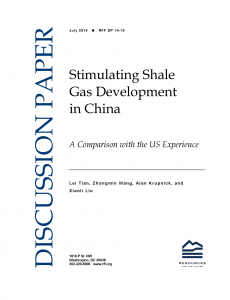 China’s pressing need to reduce coal consumption has created a strong demand for the natural gas trapped in its large shale reserves. The Chinese government has already experimented with a number of policies aimed at promoting shale gas development, but building an industry that can successfully utilize these reserves will be difficult. Although the Ministry of Land and Resources has estimated that China contains about 25.1 trillion cubic meters of recoverable gas, less than favorable geology and infrastructure will make drilling, extraction, and transportation much more challenging than in the United States.
China’s pressing need to reduce coal consumption has created a strong demand for the natural gas trapped in its large shale reserves. The Chinese government has already experimented with a number of policies aimed at promoting shale gas development, but building an industry that can successfully utilize these reserves will be difficult. Although the Ministry of Land and Resources has estimated that China contains about 25.1 trillion cubic meters of recoverable gas, less than favorable geology and infrastructure will make drilling, extraction, and transportation much more challenging than in the United States.
Despite these differences, analyzing the US shale gas experience offers useful insights into how China could overcome the problems inherent in exploiting its hard-to-reach shale reserves. In a new RFF discussion paper, with coauthors Lei Tian and Xiaoli Liu of the Energy Research Institute in Beijing, we do just that. Much like the US experience, China will need to first lower costs through investments in drilling and other innovations in order to become profitable enough to encourage further capital investment. Once an initial innovation stage has produced cost-effective technologies, a second scaling-up stage can increase production to increase profitability and explore new plays. Read More

 Subscribe; to our RSS Feed
Subscribe; to our RSS Feed Tweets by @RFF_org
Tweets by @RFF_org 
Recent Comments